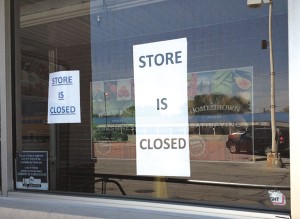The closure of many east side Marsh supermarkets in the past several months has made the “food desert” even worse say many residents. As the grocer goes into Chapter 11 bankruptcy and hopes to be bought by another company, the odds of all the Marsh stores closing are getting worse. Low income residents with no transportation to get to and from stores, or who must rely on public transit to get to the stores, are particularly hard-hit by neighborhood grocery stores closing.
“This has been a problem for a long time,” said Shaamora Harden of the Good Food Connections Far Eastside, a group that is forming to tackle the issue. In April, she met with others who share her concerns about a lack of affordable food options, including representatives of the Health Department, organizers of community gardens, and community leaders. Harden said that they are engaged in continuing conversations about the issue, and how best to tackle the problem.
One point that hit home was the lack of access to fresh food. “I talked with people at the CAFE Health Fair last month. Some people had to shop at the corner store, and the only fresh food was bananas. That’s just so sad — that’s the only options in those convenience stores for produce.”
Shifting demographics, low profit margins in traditional grocery stores, and expensive urban land have contributed to the lack of grocery stores in urban areas in general. However, in poorer neighborhoods, the lack of stores has become a crisis. According to the USDA, a food desert is an area where a third of the population is low income and living more than a mile from a full service grocery store. With a lack of full service grocery options, residents rely on convenience stores and gas station shops to purchase food. Food options at those sites tends to be higher priced, and have far less nutritional value than fresh food. Dollar stores have also jumped on the food sale bandwagon, expanding food aisles in poorer neighborhoods and adding small freezer and refrigerated groceries — but no produce or fresh food.
City-County Councilor Zach Adamson has been outspoken about the need for grocery stores in Indianapoliss, particularly the near eastside, which he represents. “The closing of Marsh is going to hurt everyone,” he pointed out. “If they close the two downtown — one that the city helped to finance, by the way — all the people who have been moving in to the downtown area will find themselves without an affordable supermarket.” He noted that the Whole Foods Market that is under construction won’t be a viable option for many residents. “That market targets the foodie culture, and people who have the money to spend $6 for a dozen eggs.”
“On Broad Ripple Avenue, you’ve got five supermarkets within a very small area, and three of them are within walking distance of residents,” Adamson pointed out. “Why crowd all those markets up in that area? These businesses want to compete for the high-end market, and left poorer neighborhoods behind.” He said that the grocery store business model has changed drastically over the years — changes he notes have left lower-income residents with fewer food options than ever before. “I have reached out to grocery chains, trying to get them to move to the area.” In Adamson’s near eastside district, there are only three full-service supermarkets and a co-op grocer, Pogue’s Run, serving a large urban population. “There are people who don’t have a car, and they are trapped. The grocery business . . . their business model used to be opening stores to serve a large customer base and maybe making a little less on every sale . . . now, they are concentrating on just the high-end customer.”
Finding solutions to the food desert problem on the east side will require a team effort, including bringing community members together. The Good Food Connection will hold a Community Conversation on June 6 at 6 p.m. at the Chickadee Garden, 8425 E. 42nd St. The public is invited to come and share information and resources.



